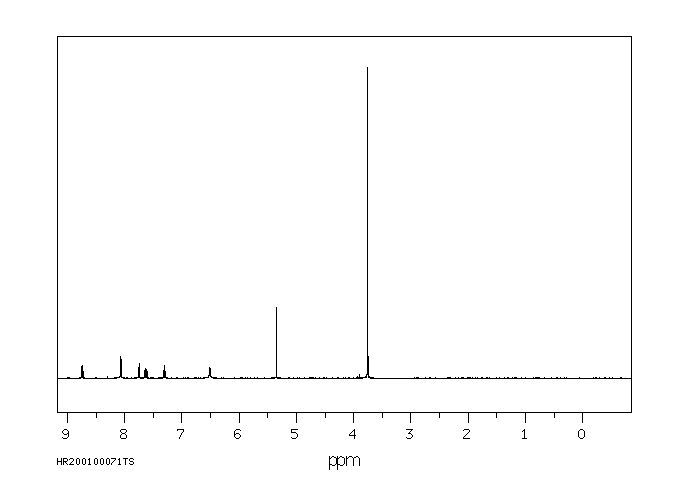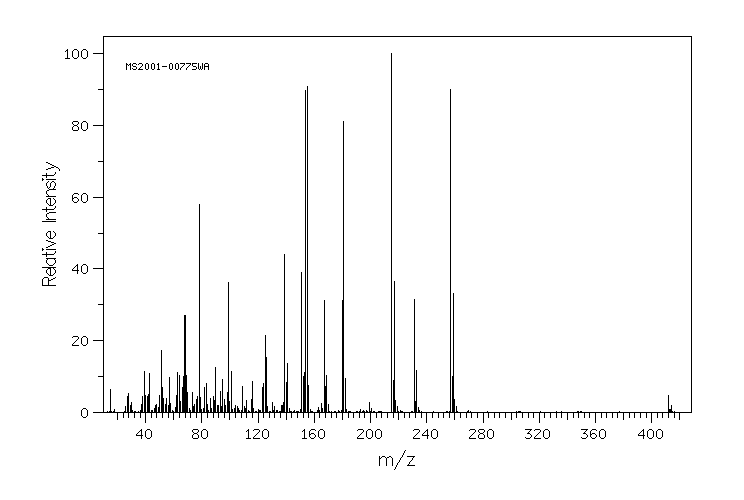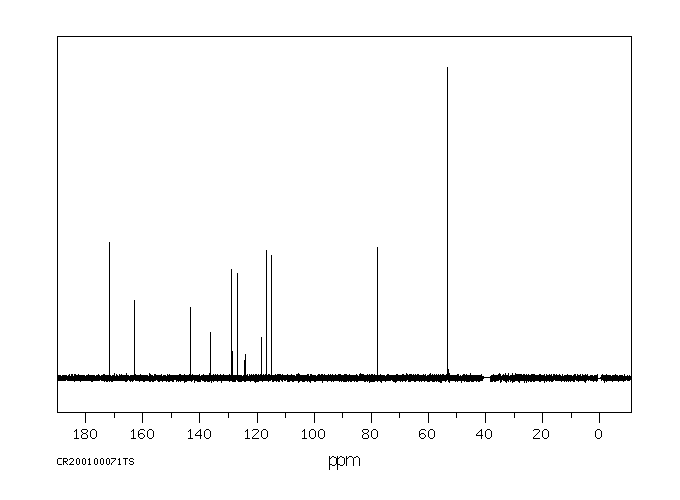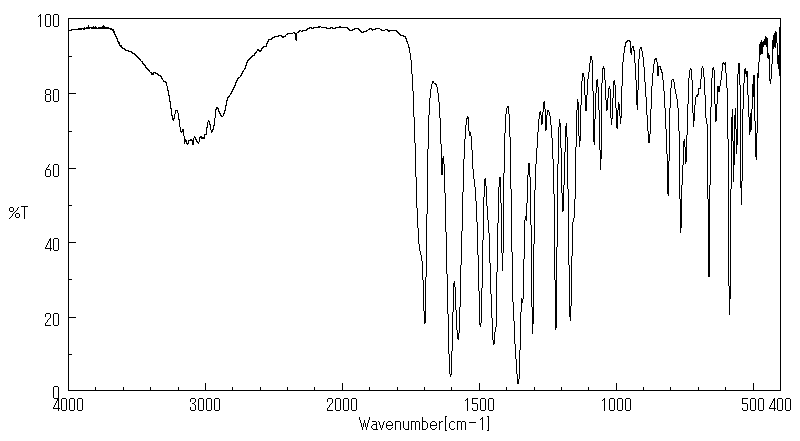咪唑磺隆 | 122548-33-8
-
物化性质
-
计算性质
-
ADMET
-
安全信息
-
SDS
-
制备方法与用途
-
上下游信息
-
文献信息
-
表征谱图
-
同类化合物
-
相关功能分类
-
相关结构分类
物化性质
-
熔点:183-184° (dec)
-
密度:d25 1.574
-
颜色/状态:White, crystalline powder
-
溶解度:In water (mg/L at 25 °C), 5 (pH 5.1), 67 (pH 6.1), 308 (pH 7)
-
蒸汽压力:3.38X10-10 mm Hg at 25 °C
-
稳定性/保质期:
Stable under recommended storage conditions.
-
解离常数:pKa = 3.94 in methanol/0.01 M citrate buffer at 252 nm
计算性质
-
辛醇/水分配系数(LogP):3
-
重原子数:27
-
可旋转键数:5
-
环数:3.0
-
sp3杂化的碳原子比例:0.14
-
拓扑面积:145
-
氢给体数:2
-
氢受体数:8
ADMET
安全信息
-
WGK Germany:1
-
海关编码:29350090
SDS
: 咪唑磺隆
产品名称
1.2 鉴别的其他方法
1-(2-Chloroimidazo[1,2-a]pyridin-3-ylsulfonyl)-3-(4,6-dimethoxypyrimidin-2-yl)urea
1.3 有关的确定了的物质或混合物的用途和建议不适合的用途
仅供科研用途,不作为药物、家庭备用药或其它用途。
模块 2. 危险性概述
2.1 GHS分类
根据化学品全球统一分类与标签制度(GHS)的规定,不是危险物质或混合物。
当心 - 物质尚未完全测试。
2.3 其它危害物 - 无
模块 3. 成分/组成信息
3.1 物 质
: 1-(2-Chloroimidazo[1,2-a]pyridin-3-ylsulfonyl)-3-(4,6-dimethoxypyrimidin-
别名
2-yl)urea
: C14H13ClN6O5S
分子式
: 412.81 g/mol
分子量
无
模块 4. 急救措施
4.1 必要的急救措施描述
吸入
如果吸入,请将患者移到新鲜空气处。 如果停止了呼吸,给于人工呼吸。
皮肤接触
用肥皂和大量的水冲洗。
眼睛接触
用水冲洗眼睛作为预防措施。
食入
切勿给失去知觉者从嘴里喂食任何东西。 用水漱口。
4.2 主要症状和影响,急性和迟发效应
据我们所知,此化学,物理和毒性性质尚未经完整的研究。
4.3 及时的医疗处理和所需的特殊处理的说明和指示
无数据资料
模块 5. 消防措施
5.1 灭火介质
灭火方法及灭火剂
用水雾,耐醇泡沫,干粉或二氧化碳灭火。
5.2 源于此物质或混合物的特别的危害
碳氧化物, 氯化氢气体, 氮氧化物, 硫氧化物
碳氧化物, 氮氧化物, 硫氧化物, 氯化氢气体
5.3 给消防员的建议
如必要的话,戴自给式呼吸器去救火。
5.4 进一步信息
无数据资料
模块 6. 泄露应急处理
6.1 人员的预防,防护设备和紧急处理程序
防止粉尘的生成。 防止吸入蒸汽、气雾或气体。
6.2 环境保护措施
不要让产物进入下水道。
6.3 抑制和清除溢出物的方法和材料
扫掉和铲掉。 存放进适当的闭口容器中待处理。
6.4 参考其他部分
丢弃处理请参阅第13节。
模块 7. 操作处置与储存
7.1 安全操作的注意事项
在有粉尘生成的地方,提供合适的排风设备。一般性的防火保护措施。
7.2 安全储存的条件,包括任何不兼容性
贮存在阴凉处。 容器保持紧闭,储存在干燥通风处。
7.3 特定用途
无数据资料
模块 8. 接触控制和个体防护
8.1 容许浓度
最高容许浓度
没有已知的国家规定的暴露极限。
8.2 暴露控制
适当的技术控制
常规的工业卫生操作。
个体防护设备
眼/面保护
请使用经官方标准如NIOSH (美国) 或 EN 166(欧盟) 检测与批准的设备防护眼部。
皮肤保护
戴手套取 手套在使用前必须受检查。
请使用合适的方法脱除手套(不要接触手套外部表面),避免任何皮肤部位接触此产品.
使用后请将被污染过的手套根据相关法律法规和有效的实验室规章程序谨慎处理. 请清洗并吹干双手
所选择的保护手套必须符合EU的89/686/EEC规定和从它衍生出来的EN 376标准。
身体保护
根据危险物质的类型,浓度和量,以及特定的工作场所来选择人体保护措施。,
防护设备的类型必须根据特定工作场所中的危险物的浓度和含量来选择。
呼吸系统防护
不需要保护呼吸。如需防护粉尘损害,请使用N95型(US)或P1型(EN 143)防尘面具。
呼吸器使用经过测试并通过政府标准如NIOSH(US)或CEN(EU)的呼吸器和零件。
模块 9. 理化特性
9.1 基本的理化特性的信息
a) 外观与性状
形状: 结晶, 粉末
颜色: 白色
b) 气味
无数据资料
c) 气味阈值
无数据资料
d) pH值
无数据资料
e) 熔点/凝固点
183 - 184 °C
f) 起始沸点和沸程
无数据资料
g) 闪点
无数据资料
h) 蒸发速率
无数据资料
i) 易燃性(固体,气体)
无数据资料
j) 高的/低的燃烧性或爆炸性限度 无数据资料
k) 蒸汽压
无数据资料
l) 蒸汽密度
无数据资料
m) 相对密度
1.574 g/cm3 在 25.5 °C
n) 水溶性
0.007 g/l 在 25 °C
o) n-辛醇/水分配系数
辛醇--水的分配系数的对数值: 0.049 在 25 °C
p) 自燃温度
无数据资料
q) 分解温度
无数据资料
r) 粘度
无数据资料
模块 10. 稳定性和反应活性
10.1 反应性
无数据资料
10.2 稳定性
无数据资料
10.3 危险反应的可能性
无数据资料
10.4 应避免的条件
无数据资料
10.5 不兼容的材料
强氧化剂
10.6 危险的分解产物
其它分解产物 - 无数据资料
模块 11. 毒理学资料
11.1 毒理学影响的信息
急性毒性
半数致死剂量 (LD50) 经口 - 大鼠 - > 5,000 mg/kg
半数致死剂量 (LD50) 经口 - 老鼠 - > 5,000 mg/kg
半数致死浓度(LC50) 吸入 - 大鼠 - 4 h - > 2.4 mg/l
皮肤刺激或腐蚀
眼睛刺激或腐蚀
无眼睛刺激
无数据资料
呼吸道或皮肤过敏
豚鼠 - 未引起试验动物过敏。
生殖细胞突变性
动物试验中未见致癌,诱变或畸变影响。 在 Ames的诱发活性试剂中无诱变现象。
致癌性
IARC:
此产品中没有大于或等于 0。1%含量的组分被 IARC鉴别为可能的或肯定的人类致癌物。
生殖毒性
无数据资料
特异性靶器官系统毒性(一次接触)
无数据资料
特异性靶器官系统毒性(反复接触)
无数据资料
吸入危险
无数据资料
潜在的健康影响
吸入 吸入可能有害。 可能引起呼吸道刺激。
摄入 如服入是有害的。
皮肤 如果通过皮肤吸收可能是有害的。 可能引起皮肤刺激。
眼睛 可能引起眼睛刺激。
接触后的征兆和症状
据我们所知,此化学,物理和毒性性质尚未经完整的研究。
附加说明
反复染毒毒性 - 大鼠 - 雄性 - 未观察到有害效果的水平 - 106.1 mg/kg
反复染毒毒性 - 大鼠 - 雌性 - 未观察到有害效果的水平 - 132.46 mg/kg
化学物质毒性作用登记: 无数据资料
模块 12. 生态学资料
12.1 生态毒性
对鱼类的毒性 半数致死浓度(LC50) - Carassius carassius (鲤鱼) - 250 mg/l - 96 h
对水蚤和其他水生无脊 半致死有效浓度(EC50) - 红虫 - > 100 mg/l - 48 h
椎动物的毒性
12.2 持久存留性和降解性
根据生物降解试验的结果,此产品属于不易降解的。
12.3 潜在的生物蓄积性
无数据资料
12.4 土壤中的迁移性
无数据资料
12.5 PBT 和 vPvB的结果评价
无数据资料
12.6 其它不利的影响
无数据资料
模块 13. 废弃处置
13.1 废物处理方法
产品
将剩余的和未回收的溶液交给处理公司。
受污染的容器和包装
作为未用过的产品弃置。
模块 14. 运输信息
14.1 联合国危险货物编号
欧洲陆运危规: - 国际海运危规: - 国际空运危规: -
14.2 联合国(UN)规定的名称
欧洲陆运危规: 非危险货物
国际海运危规: 非危险货物
国际空运危规: 非危险货物
14.3 运输危险类别
欧洲陆运危规: - 国际海运危规: - 国际空运危规: -
14.4 包裹组
欧洲陆运危规: - 国际海运危规: - 国际空运危规: -
14.5 环境危险
欧洲陆运危规: 否 国际海运危规 海运污染物: 否 国际空运危规: 否
14.6 对使用者的特别提醒
无数据资料
模块 16. 其他信息
进一步信息
版权所有:2012 Co. LLC. 公司。许可无限制纸张拷贝,仅限于内部使用。
上述信息视为正确,但不包含所有的信息,仅作为指引使用。本文件中的信息是基于我们目前所知,就正
确的安全提示来说适用于本品。该信息不代表对此产品性质的保证。
参见发票或包装条的反面。
模块 15 - 法规信息
N/A
制备方法与用途
唑吡嘧磺隆是一种乙酰乳酸合成酶(ALS)抑制剂。它通过根部吸收后输送到整株植物中。唑吡嘧磺隆能抑制杂草顶芽生长,阻止根部和幼苗的生长发育,从而导致全株死亡。
毒性唑吡嘧磺隆对鱼类和哺乳动物低毒。
化学性质纯品为白色结晶,熔点183~184℃(分解),相对密度1.574(25℃),蒸气压4.52×10^-2Pa(25℃),解离常数pKa 4。25℃时在有机溶剂中的溶解度为:二氯甲烷12.8g/L,丙酮7.6g/L,乙腈2.5g/L,乙酸乙酯2.2g/L,二甲苯400mg/L;在水中溶解度分别为308mg/L(pH=7)、67mg/L(pH=6.1)、5mg/L(pH=5.1)。分配系数为0.05。
用途唑吡嘧磺隆可通过根部吸收,然后输送到整株植物中。它能强烈抑制乙酰乳酸合成酶(ALS)这一支链氨基酸生物合成的关键酶。唑吡嘧磺隆通过抑制杂草尖芽生长,阻止根部或幼苗的生长发育,从而使杂草慢慢死亡。建议在稗草萌发前或水稻移植后10~15天使用,可以防除包括稗草在内的大多数一年生杂草及牛毛毡、萤蔺、水莎草、水芹和矮慈姑等多年生杂草。推荐使用量为30g/hm²。与其他除草剂混用可增强对稗草的防效。
生产方法-
2-亚氨基-1,2-二氢吡啶-1-乙酸的制备:将50.2g氯乙酸溶于80mL水和20mL乙醇中,在10~15℃下加入75mL三乙胺,并逐步加入2-氨基吡啶50g,加热至75~80℃反应5h。加100mL乙醇,冰水冷却后过滤洗涤,得产物64.6g(收率80%)。
-
2-氯咪唑并[1,2-α]吡啶的制备:将第一步所得产品45.7g悬浮于120mL甲苯中,在105~110℃下滴加93.1g三氯氧磷,1小时滴毕,回流5h。冷却后倒入冰水中,分出有机层水层用氢氧化钠溶液中和(30~45℃),即析出固体。水洗、干燥得产物42g(收率91.7%)。
-
2-氯咪唑并[1,2-α]吡啶-3-磺酰制备:将第二步所得产物15.3g溶于75mL二氯乙烷中,在搅拌下滴加98.5%氯磺酸14.3g,回流反应5h。冷却至20℃后,加入12.1g三乙胺,并加热回流反应3小时。冷却后注入200mL冰水中,分出有机层并负压蒸除二氯乙烷得产物24.7g(收率97.6%)。
-
2-氯咪唑并[1,2-α]吡啶-3-磺酰的制备:将第三步所得产物溶于200mL二氯甲烷中,在20~25℃下滴加6.78g(0.0433mol)氯甲酸苯酯。继续反应30min,依次加入4.2g(0.0433mol)甲磺酸和6.72g(0.0433mol)氯甲酸苯酯以及4.2g(0.0433mol)甲磺酸和6.72g(0.0433mol)2-氨基-4,6-二甲氧基嘧啶。继续回流反应5h后减压脱溶,向残余物中加入50mL乙腈过滤洗涤得最终产物15.62g(收率87.9%)。
上下游信息
-
上游原料
中文名称 英文名称 CAS号 化学式 分子量 2-氯咪唑并(1,2-a)吡啶-3-磺胺 2-chloroimidazo[1,2-a]pyridin-3-sulfonamide 112566-17-3 C7H6ClN3O2S 231.663
反应信息
-
作为产物:描述:参考文献:名称:ISIDA, YASUO;OTA, KADZUNARI;NAKAXAMA, MATSUO;JOSIKAVA, XARUTOSI摘要:DOI:
文献信息
-
[EN] ACC INHIBITORS AND USES THEREOF<br/>[FR] INHIBITEURS DE L'ACC ET UTILISATIONS ASSOCIÉES
-
[EN] 3-[(HYDRAZONO)METHYL]-N-(TETRAZOL-5-YL)-BENZAMIDE AND 3-[(HYDRAZONO)METHYL]-N-(1,3,4-OXADIAZOL-2-YL)-BENZAMIDE DERIVATIVES AS HERBICIDES<br/>[FR] DÉRIVÉS DE 3-[(HYDRAZONO))MÉTHYL]-N-(TÉTRAZOL-5-YL)-BENZAMIDE ET DE 3-[(HYDRAZONO)MÉTHYL]-N-(1,3,4-OXADIAZOL-2-YL)-BENZAMIDE UTILISÉS EN TANT QU'HERBICIDES申请人:SYNGENTA CROP PROTECTION AG公开号:WO2021013969A1公开(公告)日:2021-01-28The present invention related to compounds of Formula (I): or an agronomically acceptable salt thereof, wherein Q, R2, R3, R4, R5 and R6 are as described herein. The invention further relates to compositions comprising said compounds, to methods of controlling weeds using said compositions, and to the use of compounds of Formula (I) as a herbicide.本发明涉及以下式(I)的化合物或其农业上可接受的盐,其中Q、R2、R3、R4、R5和R6如本文所述。该发明还涉及包含所述化合物的组合物,使用这些组合物控制杂草的方法,以及将式(I)的化合物用作除草剂的用途。
-
[EN] INSECTICIDAL TRIAZINONE DERIVATIVES<br/>[FR] DÉRIVÉS DE TRIAZINONE INSECTICIDES申请人:SYNGENTA PARTICIPATIONS AG公开号:WO2013079350A1公开(公告)日:2013-06-06Compounds of the formula (I) or (I'), wherein the substituents are as defined in claim 1, are useful as pesticides.式(I)或(I')的化合物,其中取代基如权利要求1所定义的那样,可用作杀虫剂。
-
[EN] HERBICIDALLY ACTIVE HETEROARYL-S?BSTIT?TED CYCLIC DIONES OR DERIVATIVES THEREOF<br/>[FR] DIONES CYCLIQUES SUBSTITUÉES PAR HÉTÉROARYLE À ACTIVITÉ HERBICIDE OU DÉRIVÉS DE CELLES-CI申请人:SYNGENTA LTD公开号:WO2011012862A1公开(公告)日:2011-02-03The invention relates to a compound of formula (I), which is suitable for use as a herbicide wherein G is hydrogen or an agriculturally acceptable metal, sulfonium, ammonium or latentiating group; Q is a unsubstituted or substituted C3-C8 saturated or mono-unsaturated heterocyclyl containing at least one heteroatom selected from O, N and S, or Q is heteroaryl or substituted heteroaryl; m is 1, 2 or 3; and Het is an optionally substituted monocyclic or bicyclic heteroaromatic ring; and wherein the compound is optionally an agronomically acceptable salt thereof.
-
TRIAZOLE ACC INHIBITORS AND USES THEREOF
表征谱图
-
氢谱1HNMR
-
质谱MS
-
碳谱13CNMR
-
红外IR
-
拉曼Raman
-
峰位数据
-
峰位匹配
-
表征信息










